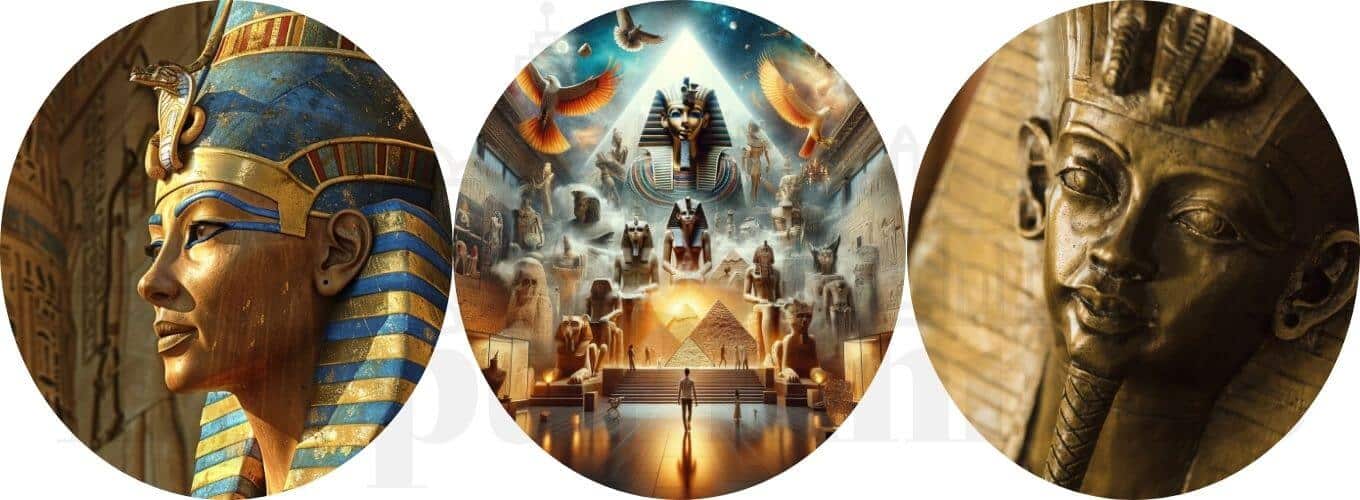Welcome, dear readers, to a captivating exploration of the On a Journey through the History of Ancient Egypt through the Ancient Egyptian Pharaohs List! As we embark on this historical odyssey, we’ll delve into the opulence, mystery, and grandeur that defined the lives of these revered rulers of ancient Egypt.
The land of the Nile has long been a cradle of civilization, and its ancient dynasties have left an indelible mark on the tapestry of human history. At the heart of this legacy are the Egyptian Pharaohs, the divine monarchs who ruled with absolute authority, commanding both mortal and immortal realms.
In this blog, a list of pharaohs in Ancient Egypt, we aim to unravel the enigmatic stories of these formidable leaders, whose reigns spanned thousands of years and shaped the destiny of a civilization. From the iconic Tutankhamun buried in the Valley of the Kings in Luxor to the mighty Ramses II, who built the Abu Simbel Temple in Aswan, each Pharaoh brought a unique essence to the throne, leaving a legacy that continues to captivate and mystify.
You can delve into ancient Egypt by visiting the places that witnessed the construction of this civilization through Ancient Egypt Tours
Key Takeaways
- The title “pharaoh” was used for rulers of Ancient Egypt after the unification of Upper and Lower Egypt by Narmer during the Early Dynastic Period, around 3100 BC.
- Native pharaohs governed Egypt for about 2500 years until the Kingdom of Kush conquered it in the late 8th century BC.
- The ancient Kings were considered divine rulers, with the power to act as intermediaries between the people and the gods.
- Many pharaohs were responsible for the construction of impressive monuments and temples, such as the iconic pyramids of Giza.
- The list of ancient Egyptian pharaohs spans from the Predynastic period (prior to c. 2900 BCE) to the Roman period (beginning 30 BCE).
Take advantage of our discounted offers with the following All-Inclusive Vacations to Egypt
- 7-Day Cairo with Nile Cruise Tour Package Get -100 USD
- 8 Days Cairo with 3 Nights Nile Cruise by Flight Get 10% Off + Free Activities
- 8 Days Cairo and Nile Cruise Holidays with Abu Simbel Get 7% OFF
- 10-Day Cairo, Alexandria, and Nile Cruise with Abu Simbel by Flight Get 10% OFF
- 12-Day Cairo City & Nile Cruise and Hurghada City
Introduction to Ancient Egyptian Pharaohs List
The ancient Egyptian pharaohs ruled from around 3100 BCE until Alexander the Great conquered Egypt in 332 BCE. They were divided into 30 dynasties, as Manetho recorded. These kings were seen as both human and divine, leading the empire politically and spiritually.
In the early dynasties, Egyptian kings had many titles. They were known as the Horus, the Sedge and Bee, and the Two Ladies. The pharaoh’s role was vast, including being a link between gods and people, owning all land, making laws, collecting taxes, and leading the military.
The Pschent crown, combining the Red and White Crowns, became the pharaoh’s official crown after unification. The title “pharaoh” was first used by Akhenaten in the 16th to 14th centuries BCE. The first dated use of the title was for “Pharaoh Siamun” in the 10th century BCE.
The pharaoh was the top priest and the first among priests. They were the state’s central figure, linking gods and humans. They ensured the Nile’s waters were managed, ensuring crops grew, defended the land, upheld justice, and fought against chaos.
The pharaohs had a complex title system. It included the Horus, Nebty, Golden Horus, Throne, and Birth names. These names showed their power and right to rule. Scholars have worked hard to understand and pronounce these names over time.The study of ancient Egyptian hieroglyphs was lost by 450 CE. It was rediscovered in the 1820s with the decipherment of the Rosetta Stone. Knowing the order of the Egyptian pharaoh list according to the timeline is difficult due to missing records, making it a bit of a puzzle to solve.
|
Period |
Dates |
Prominent Pharaohs |
|
Predynastic Period |
c. 4000-3100 BCE |
Menes (Narmer), the first pharaoh to unify Upper and Lower Egypt |
|
Old Kingdom |
c. 2700-2200 BCE |
Djoser, Khufu, Khafre, Sneferu |
|
Middle Kingdom |
c. 2000-1800 BCE |
Senusret I, Amenemhat III |
|
New Kingdom |
c. 1600-1100 BCE |
Hatshepsut, Thutmose III, Akhenaten, Tutankhamun, Ramses II |
|
Late Period |
c. 1100-332 BCE |
Nectanebo II, the last native Egyptian pharaoh |
These pharaohs, both male and female, left a lasting impact on Egypt. They shaped the country’s culture, architecture, and politics. Their legacy still fascinates the world today.
A List of Pharaohs in Ancient Egypt With A Timeline
The pharaohs of ancient Egypt were powerful rulers regarded as gods on Earth, overseeing vast empires, monumental construction projects, and the intricate religious practices that defined Egyptian civilization. Their reigns marked significant advancements in art, architecture, and governance.
We will show you the most famous 15 list of pharaohs in ancient Egypt who ruled in the past.
1- Narmer (Menes): The Actual Unifier of Upper & Lower Egypt
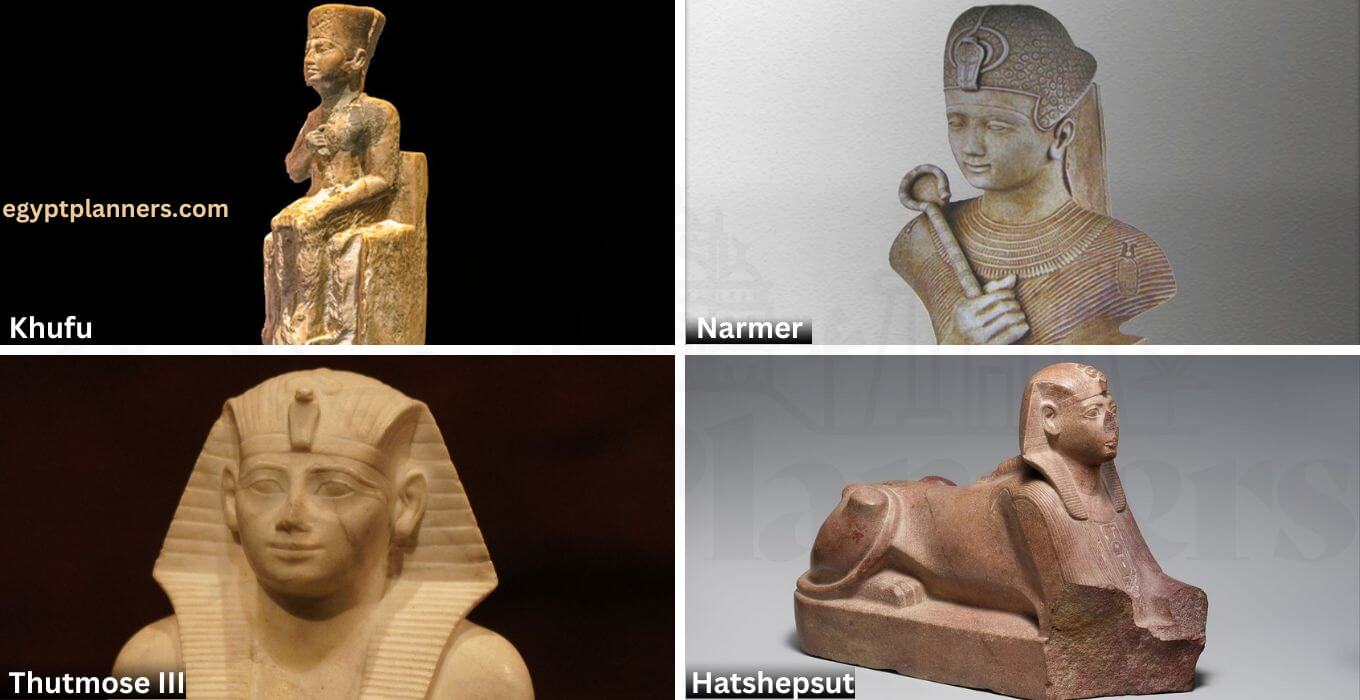
Narmer, also known as Menes, is a key figure in ancient Egyptian history. He ruled from 3273–2987 BC. Narmer is often credited with uniting Upper and Lower Egypt around 3100 BC.
This union started the First Dynasty and the Early Dynastic Period. Narmer’s rule united the two regions. He became the first pharaoh of a unified Egypt.
Many artifacts show Narmer’s achievements. The Narmer Palette and Narmer Macehead are famous. They show his military skills and his role as the first pharaoh.
There’s debate if Narmer and Menes were the same person. But most experts think Narmer was the founder of the First Dynasty, also known as Menes.
Narmer’s legacy as the unifier of Egypt is celebrated. His reign was a key moment in ancient Egyptian history. It helped create one of the most influential empires in history.
2- Khufu (Cheops): Known for Building the Great Pyramid of Giza
Khufu, also known as Cheops, was the second pharaoh of the Fourth Dynasty. He ruled ancient Egypt from around 2589 BC to 2566 BC. He is famous for building the Great Pyramid of Giza, one of the Seven Wonders of the Ancient World.
Khufu’s full name, Khnum-khufu, means “Khnum protect me.” This shows his link to the god Khnum. The exact length of his reign is not clear, but most documents date back to around 300 BC.
The Great Pyramid of Giza took about 26 years to build. It used 2.3 million large blocks, weighing around 6 million tonnes. Originally, it was the tallest human-made structure for over 3,800 years.
|
Statistic |
Value |
|
Reign Duration |
Approximately 28-29 years |
|
Construction Time of Great Pyramid |
Approximately 26 years |
|
Original Height of Great Pyramid |
146.6 meters (481 feet) |
|
Current Height of Great Pyramid |
138.5 meters (454.4 feet) |
|
Estimated Blocks Used |
2.3 million, weighing 6 million tonnes |
The Great Pyramid was built as Khufu’s tomb. It still holds his granite sarcophagus. The pyramid complex also had two mortuary temples, causeways, and smaller pyramids for his family.
Inscriptions around the site confirm Khufu’s role in the construction. This makes it clear that he built the Great Pyramid.
You can learn the details about everything related to the Great Pyramid and the pyramids in general through our article: Giza Necropolis
3- Hatshepsut: The Famous Egyptian Pharaohs Female
In ancient Egypt’s Eighteenth Dynasty, a remarkable female leader emerged. Hatshepsut, known for her building projects, left a lasting impact on Egypt.
Hatshepsut ruled from around 1473 B.C. to 1458 B.C. She was only the third woman to be a pharaoh in over 3,000 years. She started as a co-regent with her stepson, Thutmose III, but became the sole ruler for almost 20 years.
During her time, Hatshepsut worked on many projects. The famous Temple of Deir el-Bahri is one of them. It’s in the Valley of the Kings and shows her ambition. She also expanded the Karnak Temple Complex and built many obelisks.
Hatshepsut’s rule was peaceful and prosperous. Unlike many before her, she focused on trade. She led a successful trip to the Land of Punt, bringing back valuable goods like myrrh and frankincense.
But, there’s controversy about Hatshepsut’s legacy. Some think she had her image made to look like a male pharaoh. This might have been to show her strength and authority.
Hatshepsut’s achievements and her role as a female pharaoh are unforgettable. Her legacy inspires scholars and historians. It shows us the amazing things she accomplished.
4- Thutmose III: Famous for Military Leader
Thutmose III ruled from c. 1479-1425 BCE. He is called the “Napoleon of ancient Egypt” for his many military wins. He expanded Egypt’s empire a lot during his first 22 years as king.
He ruled for 54 years and won between 17 and 20 battles. He took over 350 cities, making Egypt’s empire huge. His leadership and military skills were unmatched, winning every battle.
His victories brought Egypt a lot of wealth. Egypt became a top power in the world. The Annals of Thutmose III tell of his great victories, including the Battle of Megiddo.
Thutmose III’s fame goes beyond Egypt. His obelisks are in Rome, London, New York, and Istanbul. His reign was Egypt’s golden age, thanks to his military wins and leadership.
5- Akhenaten: The One Who Calls for Worshipping Aton
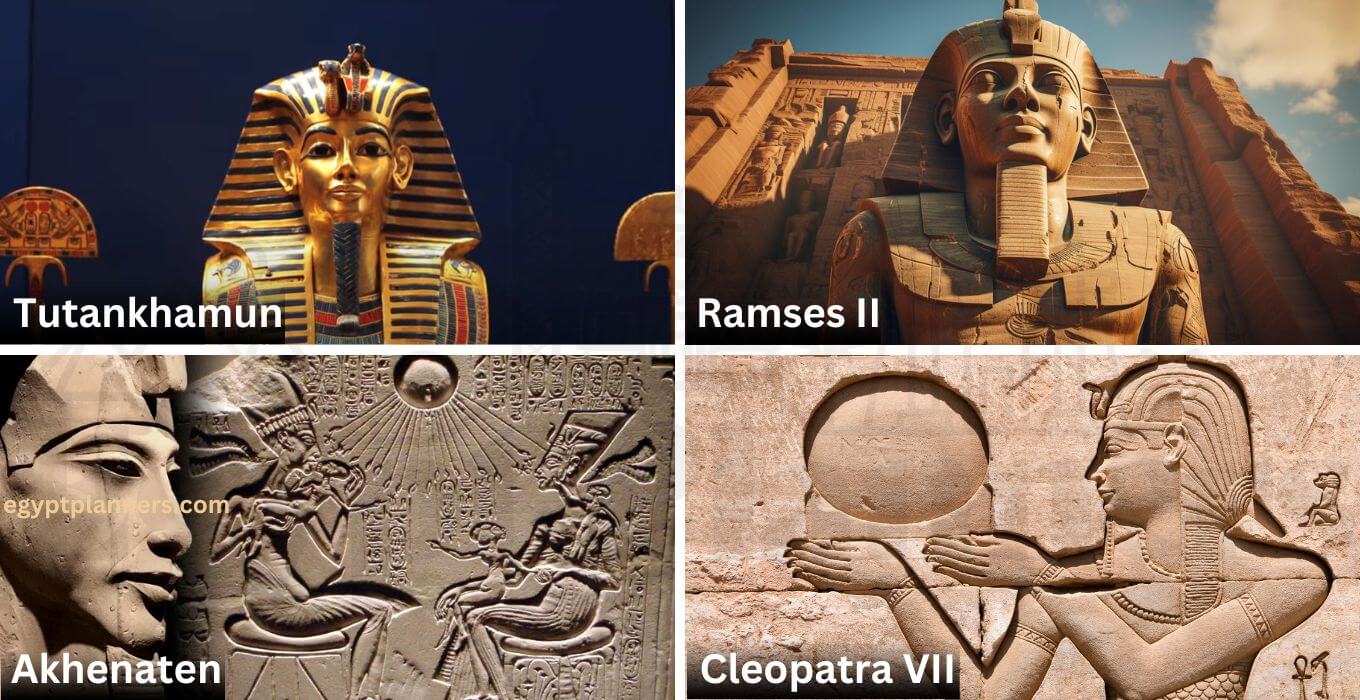
Akhenaten ruled Egypt from around 1353-1336 BCE. He is famous for changing the way people worshipped. He made Egypt focus on one god, Aten, instead of many.
This change was big and caused a lot of debate. Akhenaten didn’t like other gods, especially Amun. Some think he believed in only one god, while others don’t. But his changes affected art, buildings, and writing a lot.
Akhenaten moved the capital to a new city called Akhetaten. This city is now Tell el-Amarna. He built it to honor Aten. He used special blocks to build it, making it easier for many people to work.
What happened to Akhenaten at the end of his time is still a mystery. Where he is buried is also unknown. But his dream of changing Egypt’s beliefs is still talked about a lot.
- Akhenaten reigned during the 18th dynasty, approximately from 1353-1336 BCE.
- Akhenaten’s religious reforms centered on the worship of a single god, Aten, in contrast to the traditional Egyptian pantheon.
- Akhenaten persecuted the worship of other gods, particularly Amun, the state deity of the 18th dynasty.
- Akhenaten’s religious revolution had a significant impact on Egyptian art, architecture, and the written language.
- Akhenaten relocated the capital from Thebes to the new city of Akhetaten (present-day Tell el-Amarna).
- The end of Akhenaten’s reign and the location of his remains remain subject to ongoing debate.
“Akhenaten’s religious revolution was a bold and controversial move, as he actively persecuted the worship of other gods, particularly Amun, the state deity of the 18th dynasty.”
Akhenaten’s time was a big change for Egypt. His story is still very interesting to scholars today.
6- Tutankhamun (King Tut): Greatest Cemetery in History
Tutankhamun, also known as King Tut, was a pharaoh of the Eighteenth Dynasty. He ruled ancient Egypt from around 1333 to 1323 BCE. His tomb’s discovery in 1922 made him famous, filled with treasures and artifacts.
He died young, at 19, leading to a quick mummification and burial. His tomb was small, unlike others. Yet, it was hidden for over 3,000 years until Howard Carter found it.
The tomb’s antechamber had over 600 items, like chariots and golden beds. More treasures were found in other rooms, including golden shrines and coffins. Carter’s team found over 5,000 objects, making ancient Egyptian history famous.
|
Statistic |
Value |
|
Tutankhamun’s reign |
c. 1333 – 1323 BCE |
|
Tutankhamun’s age at death |
Approximately 19 years old |
|
Number of objects found in the tomb |
Over 5,000 |
|
Treasures of Tutankhamun exhibition visitors |
8 million in the United States |
|
Years spent excavating the tomb |
Close to 10 years |
The discovery of Tutankhamun’s tomb has amazed people for nearly a century. It made him one of the most famous pharaohs. The Grand Egyptian Museum in Cairo will open in 2025, showing more of his treasures.
7- Ramses II: One of the Most Powerful Pharaohs in History
Ramses II ruled from 1279 to 1213 BCE. He is one of the most famous pharaohs in ancient Egypt. His work in building and war made a big impact.
He had many victories in 15 military campaigns. The only exception was the Battle of Kadesh, which was a draw. This made Egypt stronger and more powerful.
Ramses II also built a lot. He built the biggest project of any pharaoh. His work includes the temples at Karnak and Abu Simbel.
He lived a long life, celebrating 13 or 14 Sed festivals. This made him one of the longest-living pharaohs. He lived to be 90 or 91 years old.
|
Statistic |
Value |
|
Reign Duration |
1279–1213 BC (66 years) |
|
Military Campaigns |
15 campaigns, all resulting in victories (except the Battle of Kadesh) |
|
Sed Festivals Celebrated |
13 or 14, more than any other pharaoh |
|
Estimated Age at Death |
90 or 91 years old |
|
Army Size |
Around 100,000 men |
Nine pharaohs after him took his name. This shows how great he was. He also made one of the first peace treaties, which is now at the United Nations in New York.
In summary, Ramses II’s rule was full of power and glory. His name is still remembered as one of the greatest pharaohs in history.
8- Cleopatra VII: The Last Active Ruler of the Ptolemaic Kingdom of Egypt
Cleopatra VII was the last ruler of the Ptolemaic Kingdom of Egypt. She was born in 70/69 BCE. She is famous for her relationships with Julius Caesar and Mark Antony. Her life played a big part in the end of ancient Egyptian civilization and its merge with the Roman Empire.
Cleopatra was part of the Ptolemaic dynasty, a Greek family ruling Egypt since 300 BCE. She took the throne in 51 BCE, ruling with family members. Her time was filled with politics, wars, and alliances with Rome, leading to her downfall.
Her bond with Julius Caesar was key. She teamed up with him to keep her throne. They had a son, Caesarion, who was her co-ruler. But after Caesar’s death, she focused on Mark Antony, having three kids with him.
Her bond with Antony led to their defeat at the Battle of Actium in 31 BCE. Faced with being paraded by Octavian, Cleopatra took her own life. This ended the Ptolemaic dynasty and her reign.
Cleopatra’s legacy is that of a powerful, smart, and charming leader. Her story, linked to the Roman Republic’s rise and fall, is celebrated in art, literature, and pop culture. She remains one of the most famous figures of the ancient world.
9- Seti I: Ramses II’s Father, Known for his Building Projects
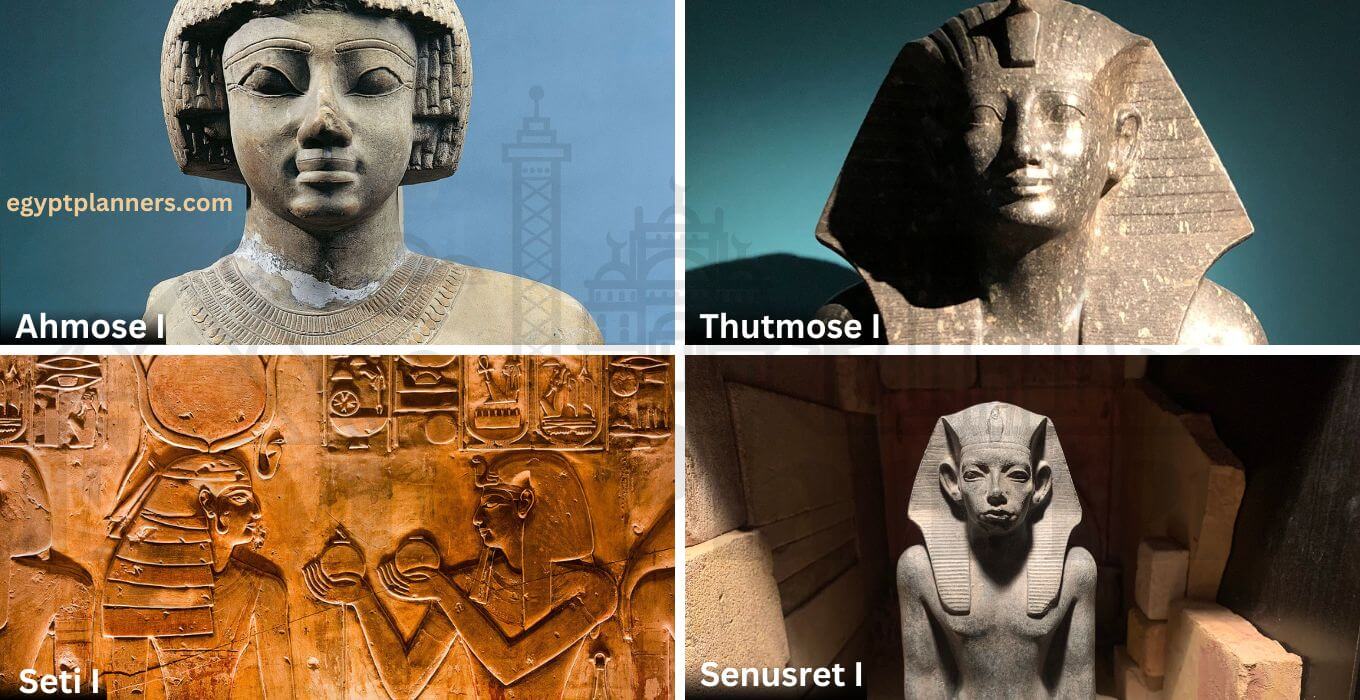
Seti I was Ramses II’s dad. He made a big impact on ancient Egypt during the Nineteenth Dynasty. He ruled from around 1294/1290 to 1279 BCE. His time was filled with great building projects and military wins.
Seti I was a strong leader in battle. He fought the Hittites, and won in Libya and Nubia. He marched through the Sinai, getting tribute from cities and beating tribes like the Shasu and Apirus (Hebrews).
He also built a lot. In his Year 9, he started big projects. But, many were not finished when he died. His 11-year reign helped his son, Ramses II, build even more.
|
Pharaoh |
Reign |
Key Achievements |
|
Seti I |
c. 1294/1290 – 1279 BCE |
|
|
Ramses II |
1279 – 1213 BCE |
|
The legacy of Seti I, Ramses II’s dad, is still fascinating today. His leadership, military wins, and big projects set the stage for the Nineteenth Dynasty’s success. He is a key figure in ancient Egyptian history.
10- Senusret I: Pioneer of Art and Architecture
Senusret I ruled ancient Egypt from c. 1971-1926 BCE. He was a key figure in the Twelfth Dynasty of the Middle Kingdom. He made big contributions to architecture and art.
Senusret I built many temples, monuments, and structures. These projects shaped the look of the Middle Kingdom.
He set Egypt’s southern border near the second cataract of the Nile. This was after two successful military campaigns in Nubia. It made Egypt’s southern border secure.
Senusret I also built shrines and temples along the Nile. This showed his control over the region.
Senusret I’s influence went beyond Egypt’s borders. He sent teams to the Sinai and Wadi Hammamat for building materials. He also made friends with rulers in Syria and Canaan. This made Egypt a strong power in the Middle Kingdom.
|
Architectural Achievements |
Artistic Innovations |
|
|
Senusret I’s work had a lasting impact on the Middle Kingdom. His vision and dedication to Egyptian culture are still celebrated today.
11- Thutmose I: A Powerful Pharaoh Who Expanded Egypt’s Borders
Thutmose I was a strong pharaoh of the Eighteenth Dynasty. He made a big impact on ancient Egypt by expanding its borders. He ruled from around 1506-1493 BCE and made Egypt a top power in the New Kingdom era.
Thutmose I showed his military strength by winning battles in the Levant and Nubia. He also put down a rebellion in Nubia in his fourth year. This made Egypt’s control over the area stronger.
He won a big victory in Nubia and dug a canal at the first cataract. This helped Egypt’s military reach further. He also won battles in Syria, crossing the Euphrates River and hunting elephants near Apamea.
Thutmose I built many things, like renovating the Middle Kingdom temple of Amon at Thebes. He added pylons, a wall, and two obelisks. He was the first to build his tomb in the Valley of the Kings at Thebes for extra security.
Thutmose I’s military wins and big projects made him a famous pharaoh. His reign was a time of conquest and expansion for the New Kingdom of ancient Egypt.
|
Key Facts about Thutmose I |
Details |
|
Reign |
c. 1506-1493 BCE (low chronology) or c. 1526-1513 BCE (high chronology) |
|
Achievements |
|
|
Legacy |
Solidified Egypt’s position as a dominant regional power during the New Kingdom period through his military campaigns and ambitious building projects |
12- Ahmose I: He Expelled the Hyksos & Reunited Egypt
Ahmose I was a key figure in ancient Egypt’s history. He ruled from about 1550-1525 BCE. His time in power was a turning point, as he chased out the Hyksos, a foreign group that had ruled parts of Egypt.
Ahmose’s battles against the Hyksos helped unite Egypt. This led to the New Kingdom era, a time of great prosperity. His victories made Egypt strong again.
- Ahmose I ruled for about 25 years, starting at just 10 years old.
- He fought the Hyksos, attacking their capital Avaris three times. This led to their defeat and Egypt’s unity.
- His armies went beyond Egypt’s borders. They might have reached Syria, Nubia, and the Euphrates River.
- The Eighteenth Dynasty, started by Ahmose, included famous pharaohs like Hatshepsut and Tutankhamun.
Ahmose I’s impact on Egypt is huge. He started the Eighteenth Dynasty and led Egypt’s victory over the Hyksos. His military skills and power helped start the New Kingdom, a time of great achievement for Egypt.
13- Nefertiti: She was the Powerful Queen & co-ruler with Akhenaten
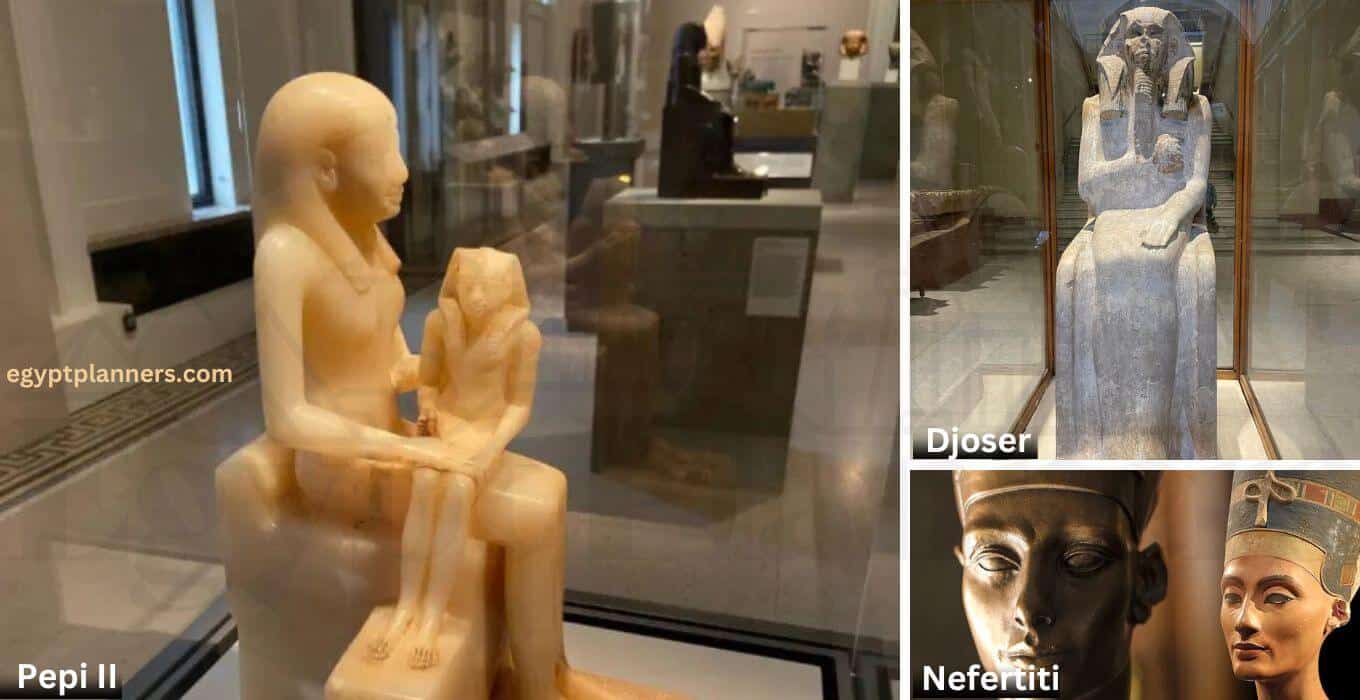
Nefertiti was a key figure in ancient Egypt, even though she wasn’t a pharaoh. She was the queen of Egypt during Akhenaten’s rule, from about 1334 BC to 1332 BC. Together, they pushed for Atenism, a belief in one god, the sun disc. This was a rich time in ancient Egypt’s history.
Nefertiti had a big role in Akhenaten’s time. She was shown fighting enemies and riding a chariot, like a pharaoh. Some think she might have even ruled as a pharaoh named Neferneferuaten after Akhenaten died.
Nefertiti and Akhenaten had six daughters. These included Meritaten, Meketaten, Ankhesenamun, Neferneferuaten Tasherit, Neferneferure, and Setepenre. Two of their daughters became queens, showing Nefertiti’s lasting impact.
There’s still debate about Nefertiti’s exact relationship with Akhenaten. Some say she was his sister, a foreign princess, or a daughter of a powerful man like Ay. But her influence on ancient Egypt is clear, and her story fascinates people everywhere.
14- Pepi II: One of the longest-reigning pharaohs
Pepi II ruled from around 2216-2153 BCE. He is known as one of the longest-reigning pharaohs in ancient Egypt. His rule, lasting over 60 years, was a key moment in the Old Kingdom’s decline.
He became pharaoh at just six years old. This was after his brother, Merenra, died unexpectedly. Pepi II was the sixth dynasty’s pharaoh.
During his long reign, Egypt saw a change in power. Nomarchs, or provincial governors, became more powerful. This change hinted at the Old Kingdom’s future collapse.
Yet, Pepi II’s reign was not all decline. He led trading expeditions and maintained relations with places like Byblos and Nubia.
Pepi II’s life was also fascinating. He was excited about a dancing dwarf brought back from a caravan. His pyramid complex in Saqqara shows the Old Kingdom’s grandeur and ambition.
15- Djoser: Owner of the Odest Huge Stone Building, “Djoser Pyramid”
The ancient Egyptian civilization saw a big change during King Djoser’s time. He ruled from about 2670 to 2650 BC. Djoser, the second king of the Third Dynasty, is famous for the Step Pyramid of Djoser at Saqqara.
The Step Pyramid was built by Imhotep, a well-known architect. It was 62.5 meters tall and had a base of 121 meters by 109 meters. It was a huge stone monument in ancient Egypt.
The early version of the Step Pyramid was a mastaba. It was 63 meters long and 8.4 meters high. Later, it was changed into the pyramid we know today.
Djoser’s rule lasted about 19 years. The Step Pyramid was built around 4,700 years ago. The area around it is 37 acres, and the moat is 131 feet wide.
The Step Pyramid started the pyramid-building program in Egypt. It led to the smooth-sided pyramids of later pharaohs, like the Great Pyramid at Giza. Djoser showed great respect for Imhotep, the architect, by carving his name on a statue.
The Step Pyramid of Djoser shows the skill of ancient Egyptian architecture in the Old Kingdom. Its unique design inspired many pyramids. It still fascinates people all over the world.
Learn more about the landmarks of Saqqara and the oldest pyramid in Saqqara through our article: Necropolis of Saqqara
FAQs: Ancient Egyptian Pharaohs List
Who were the pharaohs of Egypt in order?
The pharaohs ruled Egypt across various dynasties, beginning with Narmer (or Menes) and including famous rulers like Khufu, Hatshepsut, Akhenaten, Tutankhamun, Ramses II, and Cleopatra VII. a list of pharaohs in Ancient Egypt is extensive, spanning over 3,000 years, with many dynasties.
Who is the most famous Egyptian pharaoh?
Tutankhamun is often considered the most famous Egyptian pharaoh due to the discovery of his nearly intact tomb in 1922, which revealed a wealth of artifacts and treasures.
Who was the 1st pharaoh of Egypt?
The first in our list of Egyptian pharaohs is Narmer, also known as Menes, is regarded as the first pharaoh of a unified Egypt, around 3100 BCE, credited with uniting Upper and Lower Egypt.
Who was the real pharaoh in ancient Egypt?
All pharaohs were seen as real rulers, but their divine status was emphasized, with each pharaoh considered a living god. Notable pharaohs, like Ramses II, are often highlighted for their military successes and monumental achievements.
Why did Egypt stop having pharaohs?
Egypt ceased to have pharaohs due to a combination of foreign invasions, such as the conquest by Alexander the Great and later Roman control, leading to the end of the traditional pharaonic system by the Roman period.
Conclusion: List of pharaohs in Ancient Egypt
The ancient Egyptian pharaohs were symbols of power and leadership. They shaped a remarkable civilization. From Mina (Narmer) to Nectanebo II, they left a lasting impact on the Nile Valley.
Figures like Tutankhamun, Ramses II, and Cleopatra still fascinate us today. Their stories and legacies live on. These pharaohs were leaders and religious figures, building temples and monuments for the gods.
The kingship was often passed down from father to son. This brought stability to the ancient Egyptian dynasty. Even though queens sometimes took the throne, the pharaoh’s role was crucial. It touched every part of life, from law to trade.
Through our guide, you are now informed about Egyptian pharaohs’ timeline Whether they were Egyptian pharaohs’ names or Egyptian pharaohs’ female
You can learn more about the history of ancient Egypt through our following article:
- Eye of Horus vs Eye of Ra
- Anubis Egyptian Dog God
- 42 Ancient Egyptian Amulets
- 30 Important Ancient Egyptian Symbols
- Top 5 Egyptian Symbols for Power
- Top 8 Egyptian Symbols for Strength
- Top 15 Ancient Egyptian Good Luck Symbols
- Top 28 Egyptian Symbols Of Protection
- Revered Animals in Ancient Egypt NYT
- List of Egyptian Queen Names
- Egyptian Scarab Beetle Meaning
- Ancient Egyptian Goddess Bastet
